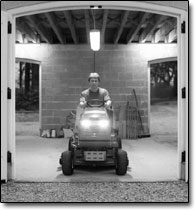
I'm certain my old bosses, both
generations of them, rolled over in the cabs of their Ford pickups.
Granted it had been a decade since I'd served one of their orders,
but the connection was still there. And those Colorado cattlemen
were the first thing that popped into my mind as I accepted a job
at (horror of all horrors) a Colorado hobby ranch.
As a fresh arrival to
Durango, I faced the same stale, local job market as most fresh
arrivals. Though tempting, the night janitor shift at McDonald's
held a limited future, and unfortunately, I'd already maxed out my
dance card for schlepping construction supplies. When things were
looking bleakest and someone suggested they could get me a job
stocking at the now defunct Big Kmart, daylight broke.
 "Ranch
Worker Wanted," the listing read. "Must be accustomed
to hard work. No housing available." "Ranch
Worker Wanted," the listing read. "Must be accustomed
to hard work. No housing available."
I promptly picked up the
phone and explained my qualifications. During all four years of
high school, a particularly nasty case of teen-age rebellion made
me shed my Telluride skin and take a job on a working cattle ranch
in nearby Norwood. And after stringing hundreds of miles of barbed
wire, bucking tens of thousands of bales, logging hour after hour
behind the wheel of a tractor, and branding, castrating and
vaccinating thousands of Herefords, I learned a little something
about land management.
During my Durango job
interview, it was these credentials that shined. My graduation with
double majors, time working at a Washington, D.C. think tank and
tenure as a newspaper editor and publisher were insignificant. And
the following day, I began work at a ranch well up Florida Road. It
would open my eyes to a new era of ranching.
After all, I had traded
a rough and tumble 1,800 acres on the west end of San Miguel County
for 80 manicured acres just east of Durango. I swapped rusty barbed
wire for upscale electric fence. The once-giant herd of 800 beef
cows had been transformed into 14 horses at the top of their breed.
And I exchanged two crusty cowboys descended from homesteaders for
a couple who had recently relocated to La Plata County from
California and purchased a piece of a now-defunct cattle
ranch.
What can I say? The
ranch was beautiful. The work promised to be interesting. And the
wages were worlds ahead of anything available downtown. I happily
slipped on my work gloves and got down to it. Immediately I was
challenged in new ways.
Three days into my job,
I received an unusual request. "We're going to shoot some video of
one of the horses," I was informed. "We need you to remove the pine
needles from the southwest pasture."
The southwest pasture
contained no fewer than 60 Ponderosa Pines and these 60 mature
trees had probably been shedding needles since shortly after Paul
Revere made his famous ride. Still, I hunkered down and did my best
to undo well over a century of history.
This standard held for
the entire property, and I found myself removing thistle and
trimming brome with a gardener's precision and picking every piece
of rock larger than a jaw breaker.
Several weeks later, the
pace of work changed when the happiest of mother nature's cycles
arrived breeding season. While many consider breeding the highest
of all endeavors, the equine version can be a little rough around
the edges. My job was to hang onto and somehow control 1,200 pounds
of stallion made crazed by mares in heat. During the courtship and
seduction process, I was to introduce the future couple either over
a fence or the "teasing wall." Through a process of kicks, snorts
and rearing, the lovers would become acquainted. Then the lady
would be temporarily taken away, only to mysteriously reappear for
the grand reunion. Occasionally, the connection needed a little
assistance and naturally it was my job to help out. My old bosses
were certainly still rolling over but this time on the ground in
laughter. Still, after about six months I started to overcome the
sense that I was somehow betraying Colorado's heritage. Yes, I
started to get the hang of gentleman ranching, and the owners and I
started seeing more eye to eye. I happily kept the fences
ship-shape, the fields maintained and the horses fat and happy. I
even started looking forward to breeding season in the same
cavalier way I'd awaited branding season. Somehow that hobby
ranch/gentleman's farm held my attention for nearly two
years.
And while I didn't
always agree with the methods, it was comforting to know that a
piece of La Plata County wasn't being overrun with noxious weeds or
worse yet, further subdivided and covered with housing.
Every day I arrived at
work the adjacent property spoke to another sobering reality. There
on a piece of that now-defunct cattle ranch, barbed wire sagged
along the fenceline, Canada thistle blanketed the field with a
giant hue of purple, and rust slowly consumed an old piece of farm
equipment. I only hope my old bosses, both generations of them, are
still finding a way to gas up those Fords, keep the fences up and
drive the cattle to the upper ranch every spring.
|

